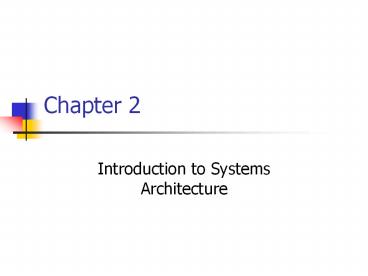Introduction to Systems Architecture - PowerPoint PPT Presentation
Title:
Introduction to Systems Architecture
Description:
Chapter 2 Introduction to Systems Architecture – PowerPoint PPT presentation
Number of Views:92
Avg rating:3.0/5.0
Title: Introduction to Systems Architecture
1
Chapter 2
- Introduction to Systems Architecture
2
Chapter goals
- Discuss the development of automated computing
- Describe the general capabilities of a computer
- Describe computer system components and their
functions - List computer system classes and their
distinguishing characteristics - Define the role and function of application and
system software - Describe the economic role of system and
application development software
3
Why invent a computer?
- What kinds of problems were people trying to
solve?
4
Primary characteristics of a computer
- General-purpose processor capable of performing
computation, data movement, comparison, and
branching functions - Storage capacity sufficient to hold large numbers
of program instructions and data - Flexible communication capability through the use
of multiple media and devices
5
Computer hardware
6
CPU Architecture
7
Storage Categories
8
Input/output capacity
- PC is a varied collection of devices connected
through internal communication (system bus) - Readings from White on evolution of the system bus
9
System bus
- How does capacity of system bus compare to CPU?
- Why is backwards compatibility an important
issue for the bus?
10
Computer System Classes
- Microcomputer/Network Computer (PC)
- Minicomputer (up to 100 simultaneous users)
- Mainframe (1000s of simultaneous users)
- Supercomputer (computationally intense
applications weather forecasting, computer
animation)
11
Computer System Classes
12
The Role of Software
13
Complexity of software creation
- Software performs a complex translation
- Identified need or task
- Human language description of how to complete the
task (algorithm, recipe, construction plan,
blueprint) - Algorithm to programming language (code)
- Programming language to machine language
- Machine language to CPU instructions (all binary,
0s and 1s)
14
Software types
- Application software
- System software
15
Systems software
- Invisible to user (ideal)
- IS professional needs to understand/configure/in
stall/maintain/update systems software
16
Software layers
17
Software/hardware layers
18
System software layers
- System management utilities called by
user/system administrator - System services functions common to many
applications carried out by system software
(print) - Resource allocation manage multiple requests
for same resource - Hardware interface carries out instructions
that operate directly on devices (device drivers)
19
Machine independence
- Layers hide specific details about hardware
- Standard service requests (print) are translated
at lowest possible level to specific hardware
instructions - Example adding a new printer changes your OS,
not every application installed on your machine
20
Machine independence (cont.)
- Placing all hardware interface functions within a
single system software layer - Concept of virtual machine (used by Java, .NET)
- Same applet is downloaded
- Each individual machine (unix, mac, windows) has
own systems level to carry out instructions from
applet
21
Operating systems functions
- Program storage, loading and execution
- File manipulation and access
- Secondary storage management
- Network and interactive user interfaces
22
Application development
- Toolkit or suite to assist in development of
software - Referred to as Integrated Development Environment
(IDE) - Programs that helps create other programs
23
Application development (cont.)
- IDE consists of
- Program translator (compiler)
- Program editors
- Debugging tools
- System development modeling tools (CASE
computer aided software engineering)
24
Computer networks
- Set of hardware and software components that
allows information, software and hardware
resources to be shared among multiple users and
computer systems
25
Network components
- External Resources
- Network Software
- Network Communication and the Physical Network
26
Chapter summary
- This chapter introduces the primary topics of the
text - Hardware
- Processor
- Software
- Operating systems
- Networks































